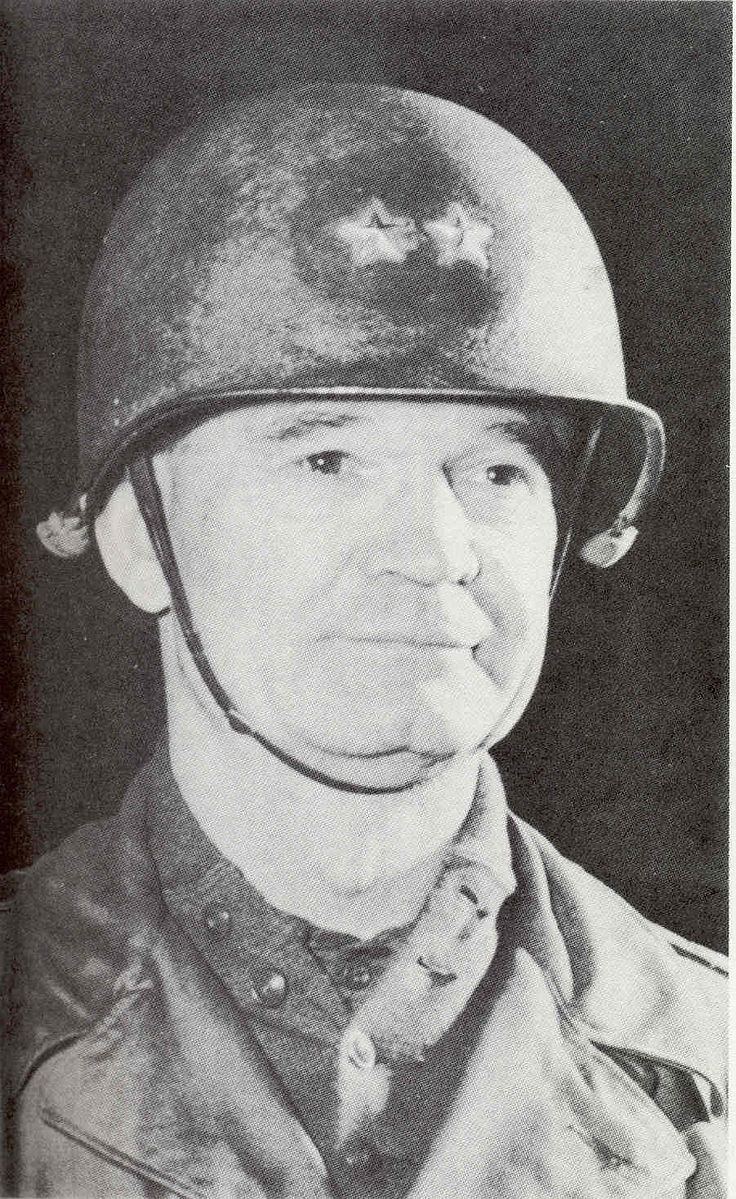Nickname(s) "Bug" Name Lunsford Oliver Years of service 1913 - 1948 | Commands held 5th Ard Division Service number 0-3536 | |
 | ||
Allegiance United States of America Battles/wars Pancho Villa ExpeditionWorld War IWorld War IIOperation TorchBattle of NormandyBattle of the Bulge Died 1978, Williamsburg, Massachusetts, United States Battles and wars Pancho Villa Expedition, World War I, Operation Torch, Operation Overlord, Battle of the Bulge, World War II | ||
Major General Lunsford Errett Oliver (March 17, 1889 – October 13, 1978) was a senior United States Army officer, who commanded the 5th Armored Division during World War II.
Contents
Early life and military career
Lunsford Erret Oliver was born on March 17, 1889 in Nemaha, Nebraska, the son of Thomas Jefferson Oliver and Mary Lorraine Evans. In 1909 he attended the United States Military Academy (USMA) at West Point, New York and graduated on June 12, 1913. Subsequently he was commissioned into the Corps of Engineers of the United States Army as a second lieutenant. Like he, many of his West Point classmates later became general officers, including Alexander Patch, Paul Newgarden, William R. Schmidt, Robert L. Spragins, Louis A. Craig, Geoffrey Keyes, Selby H. Frank, Henry Balding Lewis, John E. McMahon, Jr., Carlos Brewer, Richard U. Nicholas, Douglass T. Greene, Robert H. Van Volkenburgh, Willis D. Crittenberger, Robert M. Perkins, William A. McCulloch, Francis K. Newcomer, Charles H. Corlett, Henry B. Cheadle.
Oliver's first assignment was at Fort Brown, Texas on border patrol duty as a supply officer during the Pancho Villa Expedition. He was appointed to the U.S. Army Engineer School in Washington, D.C. for further military education and graduated on March 31, 1916. He then served with the 1st Engineer Battalion at Washington Barracks, before he was transferred to Fort Oglethorpe, Georgia. Oliver stayed on active service during World War I, organizing and training railway engineer battalions. He did not, however, serve overseas during the war and remained in the United States.
Between the wars
After the war, he contributed to the Mississippi River Flood Control Project. and then between years 1924–1927 served as an engineer in Alaska Road Commission, which was responsible for the construction of many important Alaska highways. In 1928, he attended the U.S. Army Command and General Staff School at Fort Leavenworth, Kansas for further military education.
During the years 1933–1937, Oliver served as an District Engineer in Vicksburg, Mississippi and in 1938, he attended the U.S. Army War College in Carlisle, Pennsylvania. After his War College studies, Oliver was assigned as an instructor to the U.S. Army Command and General Staff School at Fort Leavenworth, Kansas. He served in this capacity until 1940, when he was assigned as the Armored Force Engineer at Fort Knox, Kentucky. While there, Oliver, now promoted to colonel, initiated the research that led to the development of the steel treadway bridge.
World War II
Oliver was assigned to the 1st Armored Division in January 1942, a month after the Japanese attack on Pearl Harbor and the subsequent American entry into World War II, to assume command of Combat Command 'B' (CCB), then promoted to the one-star general officer rank of brigadier general on February 16, 1942. The division deployed to Northern Ireland on May 6, 1942 to train for eventual operations in French North Africa.
In September, Oliver went to London, England to assist in the planning for Operation Torch (Allied invasion of North Africa). Oliver was promoted to the two-star rank of major general on November 20, 1942, then CCB under his command landed successfully near the city of Oran in late November 1942 and started to advance toward the Djedeida airfield, occupying it with little resistance on November 28, 1942. He was awarded the Army Distinguished Service Medal. CCB encountered its first major enemy resistance at Medjez-el-bab, Tunisia where they fought for fours days starting on December 6, 1942.
Oliver returned to the United States and was appointed commander of the 5th Armored Division, where he succeeded Brigadier General Sereno E. Brett at Camp Cooke in early 1943. Oliver led the division throughout the remainder of the war, including training in the Mojave Desert near Needles, California through March 1943, the Tennessee Maneuvers through the Summer, and final validation and reorganization of the division at Pine Camp (Now Fort Drum, New York) through the winter into early 1944.
Oliver led the division on two ships to England, arriving on February 24, 1944, in preparation for the Allied invasion of Normandy. The division served on the Western Front starting with landing on Utah Beach on July 26, 1944 until Victory in Europe Day on May 8, 1945 and after. The 5th Armored Division, under Major General Oliver's command, was the first division to reach the Seine River, the first division to reach Luxembourg, the first division to fight in Germany, and when halted by orders from the U.S. Ninth Army, the division sat 45 miles from Berlin, closer than any other American division.
Decorations
Major General Lunsford E. Oliver's ribbon bar:
